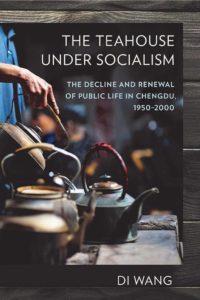 For those that don’t follow my posts too closely, this is the second book of a duo that deals with Chengdu’s public life from the end of the Qing Dynasty, all the way up to (mostly) modern day.
For those that don’t follow my posts too closely, this is the second book of a duo that deals with Chengdu’s public life from the end of the Qing Dynasty, all the way up to (mostly) modern day.
This volume picks up just where the other leaves off, in October of 1949. Events can be broadly divided into the Maoist and Post-Maoist eras, with the former seeing major reforms to businesses, and placing heavy restrictions on social life. The latter lifts much of this following the Cultural Revolution, leading to a ‘return to form’ for teahouses, and with the introduction of new technology and modern convenience further transforming the place of the humble teahouse in public life.
Looking at where these books fit into the study of tea, “Teahouse Under Socialism” and its prequel are specifically historic accounts of public life using the teahouse as a lens, as it was the most common “third place” (as termed by sociologist Ray Oldenburg). From this, the book explores Chengdu’s public life and the fate of small businesses under socialism, and how government regulations impacted people of the working class. The focus is not specifically on tea; I make that distinction to allow you to figure out if this book might be useful to your own tea studies.
This book is a lot less dense on data and statistics compared to its prequel, something Wang attributes to a general lack of primary sources from the Maoist era. Funnily, I actually found this book a little easier to read, because it wasn’t quite as dense. It’s still well-sourced, backed up with city records where they exist, and first-hand accounts from still-living residents. The book does a good job of re-introducing needed context from its prequel, so it’s not a required read, but I’d still recommend reading it to have a better understanding of where China was going into the Maoist era, and also what baseline the teahouse was returning to post-Maoist.
At the conclusion of the last book, the teahouses of Chengdu had shifted from relative abundance under the Qing Dynasty, to heavy, but unenforced regulations under the GMD. The nationalist party’s attempts did little to stem the growth of teahouses. So at the close of the last book, teahouse culture was still going strong. This changed with the rise of the Communist Party, leading into the first half of this book. The Maoist regime stifled public life, and regulations put a stranglehold on how many teahouses were allowed to operate. Teahouses, public life, and free speech suffered. Teahouses were no longer a place for news, small businesses, or entertainment, but a place for propaganda and monitoring of public opinion.
The second half of the book, following the Reform Era or Post-Mao Era, sees the resurgence of teahouses and public life under greatly relaxed regulations. Private businesses began to take back a lot of what was state-controlled, and pre-ROC traditions saw a comeback as well. The teahouses of Chengdu–as Wang describes them in the first book–were used as social and business hubs, sources of daily information, news, jobs, and places of business. Wang describes each of these aspects in detail first in The Teahouse.
Overall, it’s an interesting read about how the teahouse struggled to retain its status as the ‘public centres’ of Chengdu.
I haven’t yet read a book that focuses entirely on how the 1949-1977 regulations (such as the era of state-run communes) impacted tea producing regions directly, though Hung’s Tea Production touches on it, as does Zhang’s Ancient Caravans and Urban Chic, and finally Etherington’s Green Gold approaches it from an export standpoint. But all are a little lacking, as it isn’t their focus. I’ve still several more books on my ‘to read’ list to explore, though.
This title and its prequel aren’t yet so old as to be out of print, so their soft-cover editions can be ordered new from most major book dealers by the looks of it, averaging $40USD. For hardcover, you’ll have a slightly rougher time, as they’re out of print, but available second-hand for a good $30USD more.
- PRC History’s review, also worth a read




Leave a Reply
You must be logged in to post a comment.